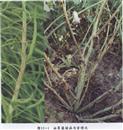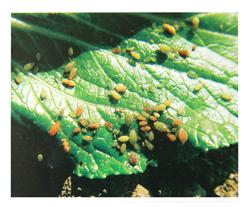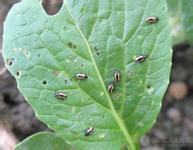Broad-leaved weeds can be removed in rape growing period.

Glycyrrhizin is a broad-spectrum herbicide with strong internal absorption and conductivity. it can be transmitted not only through stems and leaves to the underground part, but also between different tillers of the same plant. It is very destructive to the underground tissue of perennial deep-root weeds and can reach a depth that can not be reached by ordinary agricultural machinery. The herbicide has a wide herbicide spectrum and has a control effect on plants of more than 40 families, including monocotyledons, dicotyledons, annual and perennial, herbs and shrubs. Some plants of Leguminosae and Liliaceae have strong resistance to glyphosate. After entering the soil, the drug lost its activity by binding with iron, aluminum and other metal ions, and had no adverse effect on the hidden seeds and soil microorganisms in the soil. After pulling out the rape seedlings, spraying glyphosate to control the broad-leaf weeds in the field, and then planting the rape seedlings back to the field, which can effectively control the broad-leaf weeds in the field. However, because the rape seedlings are in the two-leaf and one-heart stage, it is not easy to survive after pulling out and then transplanting, which may cause a large number of dead seedlings. Broad-leaved weeds in rape growing period can be controlled by herbicide and dichloropyridinic acid. Dichloropyridinic acid is a synthetic hormone herbicide, which is mainly absorbed by the stems and leaves of weeds and transmitted by phloem and xylem, resulting in the death of weeds caused by hormonal herbicides. The drug can be transmitted to the roots through the xylem, thus killing perennial deep-root weeds. It is suitable for controlling many kinds of broad-leaved weeds such as Leguminosae, Compositae and Polygonum curly, and can effectively control big nest vegetable, small nest vegetable, tuber sweet pea, clover grass, rice Croucher vegetable. Thorns, borage vegetables, as well as authigenic alfalfa, authigenic beans and so on. This medicine and herbicide have good complementarity in herbicide spectrum, and can be used in combination with herbicide. Control annual broad-leaved weeds in the 3-6 leaf stage of weeds, with low recommended amount; control perennial broad-leaved weeds after 4 leaves of weeds to before bud formation, with high recommended amount. The drug can be used in Brassica napus and Brassica napus type rape fields, but not in mustard type rape fields, otherwise it is easy to cause drug damage. Caocaoling is a selective stem and leaf treatment agent, and it is the most commonly used herbicide to control broad-leaf weeds in rape fields at present. It can control broad-leaf weeds such as Herba Euphorbiae, etc., and has poor control effect on mother-in-law. It has a certain imitation in the application of herbicide at the age of mother-in-law, but it is basically ineffective to Croucher, mustard and nesting vegetables. The dosage of broad-leaved weeds mainly caused by calamity should be increased appropriately. Different types of rape varieties have different sensitivity to herbicide. Mustard rapeseed is sensitive to herbicide and can not be used. The drug resistance of Brassica napus is strong, but there are certain requirements for the seedling age of Brassica napus, so it is easy to cause drug damage when used in the seedling stage, so the application of pesticide in the 2-3 leaf stage of live direct seeding rape should be avoided. Generally, the drug should be used at the 6-8 leaf stage of direct seeding rape or after transplanting rape, from 2-3 leaf stage of broadleaf weeds to 2-3 branches per plant. When the temperature is high before winter or when the temperature rises after winter, the rape is treated to avoid the low temperature weather, and sometimes there are different degrees of drug damage symptoms after bolting. The rape in the above field is in the 2-leaf stage and the seedling age is relatively young. it is estimated that the broad-leaf weeds in the field have not come out yet. when the field is in the 2-4-leaf stage, the corresponding herbicides should be selected for stem and leaf treatment according to the grass phase.
- Prev

Control techniques of rape aphids
Aphids, commonly known as greasy insects, are the main insect pests of rape in Linxiang area, which occur in the main producing areas of rape. When the drought is serious in winter and spring, the insect pests are more serious in the plots lacking irrigation conditions. The harm of aphids mainly occurs in the period from bolting to maturity of rape, and some yield losses will be caused if the control is not timely or improper. First, rapeseed aphid.
- Next

Prevention and control of striped jumping beetle of rapeseed
In recent years, yellow striped flea beetle has become another major pest in the seedling stage of rape in Hongta district. The insect can not only fly but also jump, so it is difficult to catch on the leaves. When disturbed, it jumps to the ground or the ditch near the field, and then flies back to the leaves to feed, often clustered on the back of the leaves to feed.
Related
- The first cup of black tea in spring, the flavor and history of tea gardens in Kenya, Africa
- The computer can not only choose potatoes, but also grow tea rice. AI will grow winter oolong tea champion.
- It is not only the inflated tea bitten by insects, but also engraved with the four seasons tea in Beipu.
- The Oriental Beauty Tea Festival in Zhuxian County takes the stage at the weekend to experience the plus-size feast of oil tea.
- & quot; Oriental Beauty Tea & Exploration of Emei in Hsinchu, the hometown of quot;
- The new variety of strawberry "Tainong 1" dessert is the first choice with mellow aroma. Crimson gorgeous
- History of Tea in Taiwan: from Wild Inner Mountain to Export Tea Garden
- Two types of Taiwan Oriental Beauty Black Tea won the British three-Star Award for Childhood Tea Xiang Zhang Jiaqi changed from pilot to champion tea maker.
- Banana species and varieties: the planting history of Taiwan Xianren banana and dwarf banana is long, is banana disease resistant?
- Coffee planting Technology: Qianjie Coffee from Seedling to harvesting

